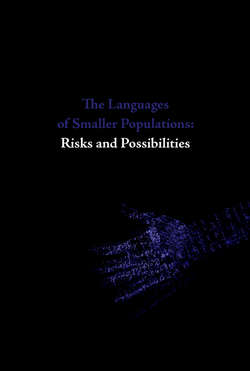The Languages of Smaller Populations: Risks and Possibilities. Lectures from the Tallinn Conference, 16–17 March 2012

Реклама. ООО «ЛитРес», ИНН: 7719571260.
Оглавление
Urmas Bereczki. The Languages of Smaller Populations: Risks and Possibilities. Lectures from the Tallinn Conference, 16–17 March 2012
CALL FOR PAPERS
Opening Words
The State and a Language of a Small Nation (The Case of Estonia) Jüri Valge. Estonian Ministry of Education and Research
The Friulians and Their ‘Piçule Patrie’ (Little Homeland): A Language and People without a State. Franco Finco. University of Udine
About the Komi Language. Nikolay Kuznetsov. Tartu University, Estonian Literary Museum
Mazatec (Popolocan) as a Multiplex Socio-Linguistic “Small World” Jean Léo Léonard (IUF & UMR 7018) Vittorio dell’Aquila (CELE & Uni Vaasa)
Livonian in 21st Century. Valts Ernštreits. Tartu University
Language Revitalisation through Language Technologies. Delyth Prys. Bangor University, Wales d. prys@bangor.ac.uk
Language or Dialect Shift? Shifting, Fading and Revival of Burgundian Gallo-Romance Varieties. To Pierre Léger. Jean Léo Léonard (IUF & Paris 3-CNRS) & Gilles Barot (Langues de Bourgogne)
In the Name of Preserving Linguistic Diversity30. János Pusztay. Szombathely – Nitra
The Effects of the Language Environment on the Acquisition of Udmurt. Irina Kuldkepp
The Mari Language on Street Signs as a Language Policy. Indicator Sven-Erik Soosaar. Eesti Keele Instituut (Institute of the Estonian Language)
The Rehabilitation of a Native Language of Forefathers in an Altered Language Space. Rainer Kuuba. Võro Institute
Cultural Survival: Strategies among Some Eurasian Minorities. Mihály Hoppál. European Folklore Institute. Institute of Ethnology. Research Centre for the Humanities. Hungarian Academy of Sciences. Budapest, Hungary hoppaltnologia.mta.hu
The Lutheran, Enlightenment and Romanticist Language. Ideologies in Early Estonian Literary Culture. Jaan Undusk
The Influence of Language Loss on Phenomena Related to a Language. Vilmos Voigt. Folklore Department, Eötvös Loránd University, Budapest
What Does the Language-Centeredness of Estonian Culture Mean? Rein Veidemann. Tallinn University, Professor of Cultural Studies
The Languages of Smaller Populations: Risks and Possibilities. Conclusion
Conference Participants. The Languages of Smaller Populations: Risks and Possibilities
Отрывок из книги
We do not know how many languages were spoken on our planet over the last two thousand years. We do know, however, that by the end of the 21st Century over 90% of the languages spoken today are endangered. It is seen as a scientific probability that of the 6,000 languages currently spoken, between 50–90% will have died out by the end of the XXI Century. Will our mother tongue be among them? This is the question that immediately comes to mind. This fear may be related to our natural instinct of self-preservation, as we tend to identify the fate of our language with the fate of our nation and the nation’s destiny with our individual fate.
The fear of the extinction of our language and our very nation may be a fear as old as human culture itself. This fear, while perhaps inherent, became part of common discourse as influenced by the thoughts and activities of Johann Gottfried von Herder (1744–1803). Herder’s concepts, the “death of nation” among them, had a direct effect on the development of several branches of science and more indirectly on the shaping of certain nations’ fates through their respective writers’ ideas and works. Cognizant of this or not, this fear of the extinction of our language still plays in our minds both consciously and subconsciously. If this instinctive fear is unavoidable, we must realize and articulate it. Thus, we would have a better chance of allaying our fears, fears which would otherwise paralyze our ability to move beyond them.
.....
Embassy of Latvia
Estonian Ministry of Culture
.....